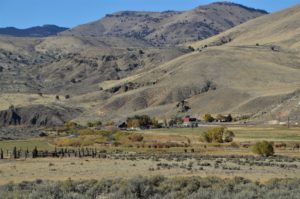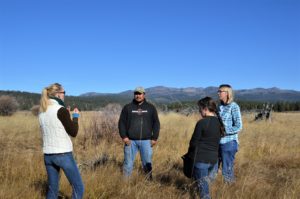
The Burns Paiute tribe has established itself as an active conservation partner in eastern Oregon
By Kathy Ferge, USDA
One of the state’s smaller tribes, the Burns Paiute tribe has established itself as an active conservation partner in eastern Oregon.
The tribe worked with the Bonneville Power Administration to purchase two off-reservation properties through the Wildlife Mitigation Program. These properties include Logan Valley in Grant County and Jonesboro in Malheur County. They also purchased property in Beech Creek in Grant County working with a traditional mortgage through Indian Land Tenure Foundation.
Vision for the Land
Lake Creek chatters in the background as Eric Hawley, Burns Paiute tribal chair and Logan Valley manager, shares his vision for the land.
“We come to stewardship from such a variety of perspectives,” said Eric. “Culturally we look at concerns based on heritage, tribal sovereignty and a search for independence. Our land management incorporates these ideas and seeks management to protect and enhance wildlife and fisheries. Our Council is also interested in economic sustainability. It is truly a balancing act.”
Even so, it’s an act the Burns Paiute perform well in partnership with USDA’s Farm Service Agency and Natural Resources Conservation Service.

Through CREP, the tribe was able to address streambank erosion along Lake Creek, Big Creek and various tributaries.
Enhancing the Land
The tribe’s relationship with USDA began in 2007 in Logan Valley, where they own over 1,700 acres of wet meadow, upland and forest.
Enrolling in the Conservation Reserve Enhancement Program, a part of the Conservation Reserve Program, the tribe partnered with FSA and NRCS to develop a plan that would enhance waterways and wet meadows. Through this program, the tribe was able to address streambank erosion on approximately 345 acres along Lake Creek, Big Creek and various tributaries.
Establishing native plant species conducive to the site was one of the key components of the CREP project in Logan Valley. On the streams, this includes species, such as Booth’s Willow, Geyer’s Willow, Western Dogwood, Wild Rose, and Golden Currant. In the tributaries, it includes stands of Quaking Aspen.
While electric and lay down fences are used to protect some plantings from cattle and elk, a short-growing season, browsing elk and incised banks have left Lake Creek with marginal populations of desired species. On Big Creek, willow and wild rose grow lushly along the stream banks that are bristling with a variety of native grass.
CREP is also being used on their Jonesboro property, on the Malheur River, helping to eliminate weeds and provide habitat for big game and birds.
Renewing Cultural Connection
For Eric, Calla Hagle, wildlife program manager for the tribe, and Erica Maltz, director of natural resources for the tribe, renewing that cultural connection between their people and the land is as important as restoring the land itself. Logan Valley, with its lush wet meadow forbs, sedges, rushes and abundant grasses, trickling streams, and towering pines provides land of true adventure for tribal youth.

The tribe holds a week-long culture camp for a hands-on learning experience.
The tribe holds its annual week-long culture camp, which involves a variety of activities for youth, from grade school through high school, to gather with tribal elders and staff from the natural and cultural resources department for a hands-on learning experience.
“I can’t emphasize enough the importance of engaging our youth with native values,” says Eric. “Connecting them with our land and our elders for a week provides depth of experience that isn’t reached any other way.”
More Information
USDA offers a variety of risk management, disaster assistance, loan, and conservation programs to help agricultural producers in the United States weather ups and downs in the market and recover from natural disasters as well as invest in improvements to their operations. Learn about additional programs.
For more information about USDA programs and services, contact your local USDA service center.
For an interactive version of this story, visit #FridaysOnTheFarm.





